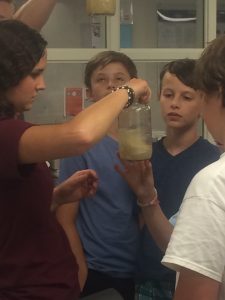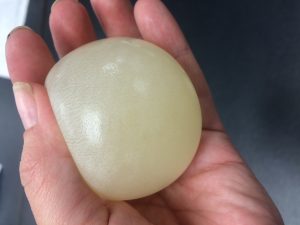LIVING SUSTAINABLY: Acid’s impact – A “Teach for Our Energy Future” lesson
By Jessica Vander Ark, West Michigan Environmental Action Council
We sure use a lot of energy. About 97.4 quadrillion Btu a year just in the U.S. – roughly the equivalent of 16 billion barrels of oil. And all that energy use has direct impact on our planet’s oceans, making them warmer and more acidic.
But do we really understand how our lifestyle choices creates that impact?
Most of our energy comes from ancient dead things that became crude oil, coal and natural gas.
Burning those fuels releases carbon dioxide into the atmosphere, which in turn traps heat in the atmosphere – the “greenhouse effect.” At the same time, the more we burn carbon-based fuels, the more carbon dioxide the oceans absorb, making them more acidic. Since the beginning of the Industrial Revolution in the 18th Century, the ocean surface has experienced a 30 percent increase in acidity.
Among other things, sea life is affected. A simple experiment can show acidification’s impact on life such as coral, clams and oysters – creatures with calcium carbonate skeletons.
First, set up (with adult supervision) three small jars with the following mixtures:
- An acidic solution: 100ml tap water and 50ml vinegar
- A basic/alkaline solution: 100ml tap water and 50ml household ammonia
- A neutral solution: 150ml tap water
Then place a whole, uncooked egg in each jar. Cover it and watch for about three days to see how changes in the pH level can impact sea life – how the shells and skeletons of calcifying organisms can be affected by acidic water. That impact on them also will change the ocean and human food webs.
So, what can you do to help? Start by understanding your own carbon footprint.
A carbon footprint is the amount of carbon dioxide your actions put into the atmosphere. Google online calculators to measure yours. Understand that energy you use – how you commute, where you get your food, products you buy, how much water you use, and how you use technology – all impact your carbon footprint.
Smaller footprints are better for the entire planet.
Each individual’s energy use affects the ocean. But with everyday choices, we can make a difference. Choices like buying local, reducing packaging and plastics, installing a solar panel, recycling, carpooling and just unplugging things – all these make a difference.
Lessons like this one, the impact of acidification, are part of a program called Teach for Our Energy Future. To download free energy lessons and experiments, go to https://wmeac.org/education.
Teach for our Energy Future was developed with a grant from the Community Foundation of the Holland/Zeeland Area to the West Michigan Environmental Action Council and was supported by the Holland Board of Public Works, Hope College’s Center for Exploratory Learning and the Holland-Hope College Sustainability Institute.
Jessica Vander Ark is director of environmental education at the West Michigan Environmental Action Council and co-developer of the Teach for Our Energy Future Project.
Photos:
4994 kids.jpg Students at a Teach for Our Energy Future camp at Hope College study the impact acidification on an egg shell.
4887 egg.jpg An egg shell becomes soft and translucent during the experiment with acidification, demonstrating the impact acidic ocean water can have on the shells of sea organisms.
![]() This Week’s Sustainability Framework Theme:
This Week’s Sustainability Framework Theme:
Community Knowledge: The collective knowledge and energy of the community is an incredible resource that must be channeled to where it is needed.
Living Sustainably is a collection of community voices sharing updates about local sustainability initiatives. It is presented by the Holland-Hope College Sustainability Institute, a joint project of Hope College, the City of Holland and Holland Board of Public Works. Go to www.hope.edu/sustainability-institute for more information.



